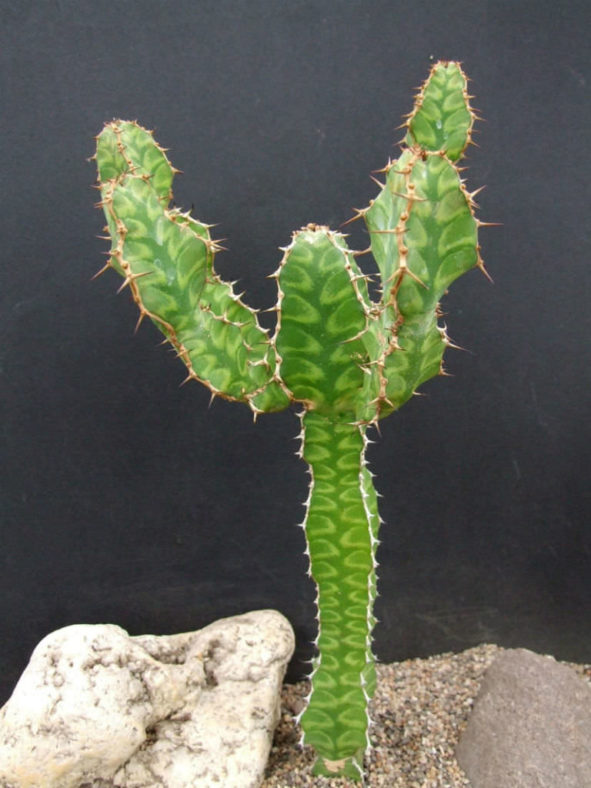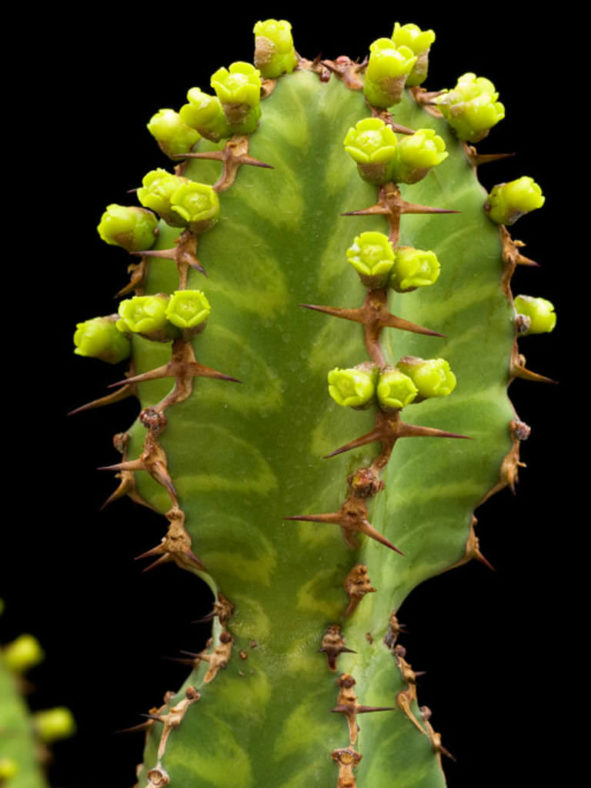Scientific Name
Euphorbia pseudocactus A.Berger
Common Name(s)
Candelabra Spurge
Scientific Classification
Family: Euphorbiaceae
Subfamily: Euphorbioideae
Tribe: Euphorbieae
Subtribe: Euphorbiinae
Genus: Euphorbia
Etymology
The specific epithet "pseudocactus (soo-doh-KAK-tus)" refers to the supposed similarity to Euphorbia cactus, a native of Southern Arabia and Eritrea.
Origin
Euphorbia pseudocactus is native to South Africa (KwaZulu-Natal).
Description
Euphorbia pseudocactus is a succulent shrub with a short main stem producing many suberect branches irregularly constricted into segments according to the annual growth. It can grow up to 3.3 feet (1 m) tall and 6.6 feet (2 m) in diameter. The branches are 4- or 5-angled or occasionally only 3-angled. They are green, usually with yellowish-green, V-shaped markings radiating from the grooves. The branch segments are usually thickest below the middle, grooved or nearly flat between the angles, measuring up to 6 inches (15 cm) long and 1.8 inches (4.5 cm) thick. The angles are wavy with tubercles 0.4 to 0.6 inches (1 to 1.5 cm) apart, each with a pair of stout spines at the tip. The spine shields are united into a continuous horny margin along the angles. The spines are brown, soon becoming grey, and can grow up to 0.4 inches (1 cm) long.
The cymes consist of 3 vertically disposed cyathia, with the central one male and the two lateral ones bisexual. The cyathia has five oblong yellow glands. They occur from late winter to late summer. The fruits are 3-angled capsules measuring up to 0.6 inches (1.5 cm) in diameter and containing subglobose seeds.

Hardiness
USDA hardiness zones 9b to 11b: from 25 °F (−3.9 °C) to 50 °F (+10 °C).
How to Grow and Care
Euphorbias are very easy to care for. These plants require a little pampering to become established, but once they are, they are self-sufficient. In fact, more die from too much care and watering than from neglect. Euphorbias need well-draining soil and lots of sunlight. They are not particular about soil pH but cannot tolerate wet soil. Unlike most succulents, Euphorbia does not handle long periods of drought well. It may need weekly watering during the summer. Water whenever the soil is dry several inches below the surface. Water deeply, but don't let them sit in wet soil, which can cause root rot. Add some organic matter or fertilizer to the planting hole. Feed with a half-strength fertilizer monthly if you are growing them in containers or your soil is poor.
These succulents can be grown from seed, but they can be difficult to germinate (or even find). They are usually propagated by cuttings. This can be tricky because of the exuding sap. Rooting hormone is recommended with Euphorbias. They tend to grow problem-free, but a few pests and diseases are to be alert for.
Learn more at How to Grow and Care for Euphorbia.
Hybrids
Links
- Back to genus Euphorbia
- Succupedia: Browse succulents by Scientific Name, Common Name, Genus, Family, USDA Hardiness Zone, Origin, or cacti by Genus
Photo Gallery
Click on a photo to see a larger version.


